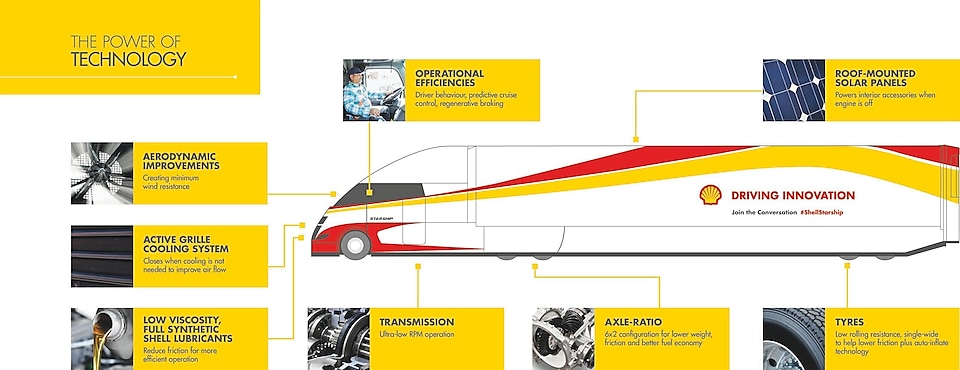
Pushing the Limits of Fuel Efficiency for Trucks
An ambitious hyper-fuel-efficient truck project that crossed the USA shows that it’s possible to achieve fuel efficiency and lower carbon footprint by using currently available technologies and solutions.
By Elitza Terzova, Global Fuels Product Manager of Shell Commercial Fuels on Aug 05, 2019
When concept-truck builder Bob Sliwa pulled off Interstate 10 to arrive in Jacksonville, Florida after completing a coast-to-coast drive of the USA, he didn’t quite know it yet, but he was potentially transforming the industry conversation around fuel efficiency irreversibly1. In his six-day journey from San Diego, the founder of AirFlow Truck Company had demonstrated a 2.48 times improvement in freight tonne efficiency2. And he did it in a truck carrying significantly more weight than average3.

That truck was the vehicle at the centre of the Starship Project – a hyper-fuel-efficient Class 8 semi, co-engineered by AirFlow Truck Company and Shell – powered not by an alternative fuel, but by diesel4. Equally notably, the truck’s fuel efficiency was maximised through modifications using currently available technologies.
The role of diesel here is key: though a growing number of new heavy-duty vehicles run on alternative fuels, the average lifespan of a European truck is 12 years, meaning there will continue to be plenty of diesel vehicles on the roads over the coming years5. On top of this, one IHS Markit report suggests that advancements in the diesel engine will allow it to remain cost competitive until at least 20406. The evolution of existing fuel technologies is enabling improvements in: engine cleanliness, engine efficiency and fuel economy – all of which ladder up to the much sought-after total cost of ownership (TCO) and CO2 emissions reduction for commercial fleets7.
With this in mind, if the industry wants to hit its increasingly tighter targets — on fuel efficiency, running costs and carbon footprint — it must look to examples such as the Starship Project as inspiration for how we can best optimise these diesel-powered vehicles. In fact, the Starship truck exists as proof that leveraging existing technologies for our fleets now, is one viable option to help make road transport more efficient and lower carbon for tomorrow.
Advancements in the diesel engine will allow it to remain cost competitive until at least 2040.
How today’s technology can help meet tomorrow’s goals
For those companies whose business and performance depends on a heavy-duty fleet, success relies on identifying the factors that are reducing efficiency and then effectively targeting them, such as in the case of the Starship Project.
These could include vehicle drag – both wind resistance and rolling resistance – which slows a vehicle down and reduces efficiency. To combat this, the Starship truck used a 100% carbon fibre cab with a streamlined and aerodynamic shape to help cut wind resistance. A gap closure system, boat tails off the back of the trailer, and full-length side skirts were also implemented to reduce wind resistance. Meanwhile, an automated system sensed when tyre pressure was low, then self-inflated as required, thereby reducing rolling resistance. Together, these two innovations helped keep the forces of drag at bay, while also increasing fuel effectiveness.
Another way to increase efficiency, is to make the most of present-day available fuel options. For many fleet operators this can be achieved through the use of diesel fuels with performance-enhancing additives. In the case of the Starship truck, a downspeed axle configuration, with advanced engine controls and automated manual transmission, improved efficiency and pulling power.

‘What you put in matters’ when it comes to fuel efficiency
While the hardware technologies used to design, build and operate the vehicle are the foundation of a hyper-efficient next-generation diesel truck, the success of the Starship Project also underlines the importance of what goes into the vehicle.
Alongside other best practice solutions, choosing premium consumables – that are specially formulated to protect truck engines and maintain peak performance under demanding conditions – can help fleet managers meet their current performance and efficiency targets, while also setting them up for future successes.
For example, the Starship truck used high-performance, low-viscosity Shell lubricants to help reduce friction in the engine. Compared to standard lubricants, these were shown to create a 2.6% benefit in fuel economy when compared to SAE 15W-40 oils, cutting fuel consumption while still providing premium protection against wear8.
Likewise, as touched on above in regards to diesel fuels with additives, what is in the tank can have a significant impact. Research has found that optimum fuel selection and management (including usage, storage and handling) can deliver fleet cost savings of up to 30%9. Reinforcing the importance of collaborating with industry experts, this also demonstrates how efficiencies provided by available technologies can help achieve current-day targets and long-term goals.
Among these solutions is Shell FuelSave Diesel with its dual detergent DYNAFLEX Technology, which is designed to help prevent the build-up of harmful carbon deposits on the injectors and remove any already present. This means the fuel can help increase both engine efficiency and fuel economy.
Research has found that optimum fuel selection and management (including usage, storage and handling) can deliver fleet cost savings of up to 30%.
A more efficient fleet is possible even today
Which brings us back to Bob Sliwa, who first entertained the idea of creating a super-aerodynamic, hyper fuel-efficient Class 8 rig alongside Shell; not only because of how inefficient he thought long-haul trucks were, but because he saw the potential improvements that could be made for future success. And he believed they could be implemented right now.
That is not to say every truck can be as easily well-equipped as the Starship truck. But what is clear, is that increased vehicle efficiency is attainable for today’s fleet operators and this greater efficiency can go a long way to meeting the increasingly demanding goals that the transport industry of the future will encounter, such as lowering TCO and reducing carbon footprint. To get ahead of the curve, the technologies that are available today should be viewed by fleet operators as genuine enablers for their business, with regards to performance and profitability.
From choosing the most effective vehicle, fuel and lubricant technologies to capitalising on advice and collaboration with energy and technology experts, the Starship Project’s remarkable journey confirms the opportunity in front of fleet operators. An opportunity that requires them to act now to identify truck efficiency improvements, then use available technologies to capitalise on them.
Footnotes
1 Interstate 10 (I-10) is the southernmost cross-country interstate highway in the American Interstate Highway System. It stretches from the Pacific Ocean at California State Route 1 (Pacific Coast Highway) in Santa Monica, California, to I-95 in Jacksonville, Florida. Major cities connected by I-10 include (from west to east) Los Angeles, Phoenix, Tucson, El Paso, San Antonio, Houston, Baton Rouge, New Orleans, Mobile, Tallahassee, and Jacksonville.
2 Freight tonne efficiency is the favoured statistic for judging the energy intensity associated with moving cargo from point A to B since it combines the weight of cargo being moved with the amount of fuel consumed.
3 Shell.com (2018). Shell and Airflow Truck Company Demonstrate a 248% Improvement in Freight Tonne Efficiency with the Starship Truck. Available at
4 Shell.com (2018) Starship – Hyper-Fuel Efficient Truck. Available at
5 Acea.be. (2019). Average Vehicle Age | ACEA - European Automobile Manufacturers' Association. Available at
6 Trentacosta, M., Evans, D., Hardin, K. and Maguire, A. (2019). Reinventing The Truck. Cdn.ihs.com. Available at
7 Total Cost of Ownership (TCO) is defined by Shell Lubricants as the total amount spent on industrial equipment, including cost of acquisition and operation over its entire working life, including costs of lost production during equipment downtime.
8 TTNews.com (2018). Low-Viscosity Engine Oils Will Support Push for Improved Fuel Economy, Shell Says. Available at
9 Making Fuel Work For Your Bottom Line. (2018). 1st ed. London: Shell Commercial Fuels, p.6.





